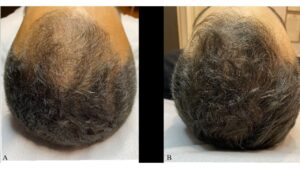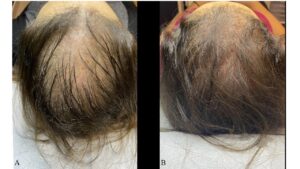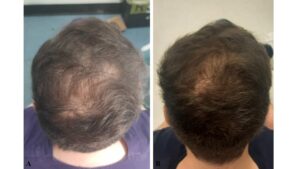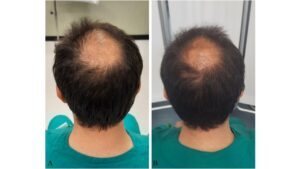Lodi G1, Pellerone S1, Cerullo F1, Baroni A1*
1Department of Dermatology, University of Campania “Luigi Vanvitelli”, Naples, Italy
*Correspondence author: Adone Baroni, MD, PhD, Department of Dermatology, University of Campania “Luigi Vanvitelli”, Naples, Italy;
Email: [email protected]
Published Date: 22-07-2024
Copyright© 2024 by Lodi G, et al. All rights reserved. This is an open access article distributed under the terms of the Creative Commons Attribution License, which permits unrestricted use, distribution, and reproduction in any medium, provided the original author and source are credited.
Abstract
Androgenetic Alopecia (AGA) is a common condition affecting men and women, characterized by progressive hair follicle miniaturization and consequent hair loss. Blue light Photobiomodulation (PBM) by LED (Light emitting diode) device and infiltrations of biomimetic peptides therapy are two emerging approaches for AGA treatment. The aim of this study was to evaluate the efficacy of a combined protocol of blue light PBM and infiltrations of biomimetic peptides on the scalp for AGA treatment. A total of 20 patients with AGA diagnosis, according to Hamilton-Norwood criteria, were enrolled in the study. All patients were treated at the same time, both with Blue light LED and with subcutaneous infiltrations of biomimetic peptides on the scalp. At 6 months follow-up, a significant increase in hair density was observed in 85% of the patients treated. The results of our study suggest that the combined protocol of blue light PBM and biomimetic PRP could be an effective treatment for AGA. Further clinical studies with a larger number of patients are needed to confirm these results and to evaluate the long-term efficacy of the treatment.
Keywords: Androgenetic Alopecia; Opsin3; Blue Light; Biomimetic Peptides; Platelet-Rich Plasma
Introduction
Androgenetic Alopecia (AGA) is a common condition affecting men and women, characterized by progressive hair follicle miniaturization and consequent hair loss [1]. Blue light PBM and infiltrations of biomimetic peptides therapy are two emerging approaches for AGA treatment.
Blue light has proven to be an innovative and interesting therapy for the treatment of AGA [2,3]. Opsins are members of the G protein-coupled receptor superfamily with molecular masses of 30-60 kDa. They are light sensors in animals: the Opsin3 (OPN3) photoreceptor is a protein encoded by the OPN3 gene. It regulates melanogenesis in melanocytes via inhibition of alpha-MSH-induced MC1R-mediated cAMP signaling, modulation of calcium flux, CAMK2 phosphorylation, and subsequently phosphorylation of CREB, p38, ERK and MITF, in response to blue light irradiation [4].
Opsins can change their conformation into a signaling state upon light absorption, which activates the G protein, resulting in a signaling cascade that produces physiological responses [5].
OPN3 is present in many tissues and on the cells of the outer sheath of hair follicles. The interaction between blue light and OPN3 has been shown to significantly prolong the anagen phase in hair follicles: silencing of OPN3 on the cells of the outer sheath of hair follicles, stimulatory effects of blue light is abrogated [6].
Moreover, clinical studies have demonstrated that infiltrations of biomimetic peptides on the scalp could represent a valid and safer alternative to autologous Platelet-Rich Plasma (PRP) for the treatment of Alopecia areata [1,7]. The aim of this study was to evaluate the efficacy of a combined protocol of blue light PBM and infiltrations of biomimetic peptides on the scalp for AGA treatment.
Material and Methods
A total of 20 patients (8 females/12 males; median age: 35 years, range: 29–59 years) with AGA diagnosis, according to Hamilton-Norwood/Ludwig criteria, were enrolled in the study (Fig. 1-4). Patients who had already practiced topical and oral therapies in the last six months were excluded from the study. Among the 12 male patients: two patients belong to grade II, five patients to grade III, three patients to grade III vertex and two patients to grade VI, of Hamilton-Norwood scale. Among the 8 female patients treated with our protocol: six patients belonged to stage 2, one patient to stage 1, and one patient to stage 3, of the Ludwig scale (Table 1).
All patients were treated at the same time at Department of Dermatology of University of Campania “Luigi Vanvitelli” in Naples (Italy), both with Blue light LED device (HEVA-Light System), at 417 ± 10 nm, fluence of 120 J/cm2 and power intensity of 60 mW/cm2 ± 20% positioned at 10 cm distance from the scalp, for a time of 18 minutes per session, with 1 session per week for 6 consecutive weeks, and with 1 session of subcutaneous infiltrations of biomimetic peptides (Bioplacy – Mesorga) on the scalp every 2 weeks for 6 total sessions. In this study we used a commercial biomimetic PRP preparation with five growth factors (EGF, IGF-1, acid FGF, alkaline FGF and VEGF). The solution is injected in very small drops with a microneedle into the patient’s dermis to stimulate the various structures. The patient will only feel the tingling of the holes that will be drilled to allow product penetration. The session is very short, the treatment lasts 15/30 minutes. In the post-treatment, the treated area appears reddish and exposure to excessively hot temperatures, physical activity or showering were avoided for 24 hours 7. Visual Analog Scale (VAS) score was used to evaluate the patient satisfaction rate in a range from 0 to 10. All patients declared a VAS >8.
Patients | Norwood scale | Ludwig scale |
1 | II | |
2 | II | |
3 | I | |
4 | III | |
5 | III | |
6 | III | |
7 | III | |
8 | III | |
9 | II | |
10 | II | |
11 | II | |
12 | II | |
13 | II | |
14 | II | |
15 | III vertex | |
16 | III vertex | |
17 | III vertex | |
18 | III | |
19 | VI | |
20 | VI |
Table 1: Among the 12 male patients: two patients belong to grade II, five patients to grade III, three patients to grade III vertex and two patients to grade VI, of Hamilton-Norwood scale. Among the 8 female patients treated with our protocol: six patients belonged to stage 2, one patient to stage 1, and one patient to stage 3, of the Ludwig scale.
Results
Patients were evaluated at baseline and at 3, 6 and 12-months follow-up using photographic clinical images, trichoscopy and patient satisfaction rate (Fig. 1-4). Trichoscopy has emerged as a useful diagnostic tool for AGA. Important features of AGA on trichoscopy are Hair Diameter Diversity (HDD) greater than 20% (which corresponds to vellus transformation), perifollicular pigmentation/peripilar sign and yellow dot [7,8].
At 3 months follow-up, a significant increase in hair density, visible clinically and through trichoscopy, was observed in 70% of the patients treated with the combined protocol of blue light PBM and infiltrations of biomimetic peptides. We observed a decrease of yellow dots and an HDD decreased to 10% compared to the initial 22%, which corresponds to the transformation of vellus hairs into terminal hairs.
Additionally, an improvement in reduction of hair loss, hair density, and hair thickness, and patients’ aesthetic satisfaction was detected and assessed through specific questionnaires (VAS). At 6 months follow-up the hair density increased in 85% of patients, that at 12 months follow-up remained preserved.

Figure 1: A: Patient affected from AGA before treatment; B: a significant increase in hair density and reduction of hair loss, after treatment with the combined protocol of blue light PBM and infiltrations of biomimetic PRP.

Figure 2: A: Patient affected from AGA before treatment; B: a significant increase in hair density and reduction of hair loss, after treatment with the combined protocol of blue light PBM and infiltrations of biomimetic PRP.

Figure 3: A: Patient affected from AGA before treatment; B: a significant increase in hair density and reduction of hair loss, after treatment with the combined protocol of blue light PBM and infiltrations of biomimetic PRP.

Figure 4: A: Patient affected from AGA before treatment; B: a significant increase in hair density and reduction of hair loss, after treatment with the combined protocol of blue light PBM and infiltrations of biomimetic PRP.
Discussion
Biomimetic peptides or biopeptides are molecules composed of a sequence of amino acids linked by peptide bonds. Biopeptides can be classified as: Peptide hormones, neuropeptides, cytokines, growth factors. Peptides that act as growth factors influence the expression and synthesis of different proteins, which is accompanied by important structural improvements [9].
The main reservoir of GF is the alpha-granules of platelets and new procedures aimed at the collection of Platelet-Rich Plasma (PRP) have been implemented. PRP has been safely used in many medical applications and as an alternative cell therapy for the treatment of hair growth disorders.
The substantial difference between classic and biomimetic PRP lies in the fact that the use of biomimetic PRP exclude the risks of contamination, they are totally sterile and, therefore, the risk of contamination is almost zero. It should also be remembered that the rules on the use of this method in Italy in the aesthetic field are unclear. To be able to practice the classic PRP treatment, it is not enough to have the authorization for a medical clinic, but specific authorizations are regulated differently from region to region [9].
There is a lack of universal consensus on methods of preparation and administration of PRP, evaluation of results, the addition of exogenous platelet activator, optimal platelet concentration, and benefits or detriments of leukocytes [10]. External anticoagulant must be added in preparation for PRP hence the treatment is not purely autologous. Therefore, some individuals may have allergies to anticoagulants [11].
Biomimetic PRP are structured by multifunctional peptides that stimulate the hair follicle cells on 3 levels: Differentiation, Proliferation, Protein synthesis. Differentiation: Pluripotent stem cells located in the dermal papilla. Proliferation: Activation of the expression of the genes responsible for the formation and multiplication of new cells and proteins of the hair shaft. Protein synthesis: Activation of the growth phase or terminal hair anagen phase.
Synthetic growth factors act on the stem cells of the bulb, support the regeneration of the hair follicle, and promote its nourishment, thus reversing the thinning process, activate the hair growth phase and the formation of new follicles; the hair follicle regenerates, promoting hair growth.
Conclusion
The results of our study suggest that the combined protocol of blue light PBM and biomimetic PRP could be an effective treatment for AGA. The two approaches have a synergic action that stimulates hair growth, counteracts hair follicle miniaturization, and improves scalp quality in our patients. Our study provides preliminary evidence of the efficacy of the combined protocol of blue light PBM and biomimetic PRP for AGA treatment. The combination of these two technologies represents a promising potential therapeutic approach for this condition. Due to the small sample size, further clinical studies with larger numbers are needed to confirm these results and to evaluate the long-term efficacy of the treatment.
Conflict of Interests
The authors declare that there is no conflict of interest for this paper.
References
- Wall D, Meah N, Fagan N, York K, Sinclair R. Advances in hair growth. Fac Rev. 2022:11:1.
- Lodi G, Sannino M, Cannarozzo G, Giudice A, Del Duca E, Tamburi F, et al. Blue light-emitting diodes in hair regrowth: The first prospective study. Lasers in Medical Science. 2021;36(8):1719-23.
- Lodi G, Del Re C, Nisticò SP, Bennardo L, Cannarozzo G, Sannino M. Blue light‐emitting diodes for the treatment of localized vitiligo: A retrospective study. J Cosmetic Dermatol. 2023;22(4):1273-8.
- Regazzetti C, Sormani L, Debayle D, Bernerd F, Tulic MK, De Donatis GM, et al. Melanocytes sense blue light and regulate pigmentation through opsin-3. J Invest Dermatol. 2018;138(1):171-8.
- Shichida Y, Matsuyama T. Evolution of opsins and phototransduction. Philos Trans R Soc Lond B Biol Sci. 2009;364(1531):2881-95.
- Buscone S, Mardaryev AN, Raafs B, Bikker JW, Sticht C, Gretz N, et al. A new path in defining light parameters for hair growth: Discovery and modulation of photoreceptors in human hair follicle. Lasers Surg Med. 2017;49(7):705-18.
- Shigeki I. Trichoscopy for common hair loss diseases: Algorithmic method for diagnosis. J Dermatol. 2011;38:71-5.
- Rakowska A, Slowinska M, Kowalska-Oledzka E, Olszewska M, Rudnicka L. Dermoscopy in female androgenic alopecia: Method standardization and diagnostic criteria. Int J Trichol. 2009;1:123-30.
- Rinaldi F, Marzani B, Pinto D, Sorbellini E. Randomized controlled trial on a PRP-like cosmetic, biomimetic peptides based, for the treatment of alopecia areata. J Dermatolog Treat. 2019;30(6):588-93.
- Shrestha S, Pathak R, Jagat GC, Donovan J. Platelet-rich fibrin: A review of its role as a new treatment in androgenetic alopecia. J Cosmet Dermatol. 2024.
- Shashank B, Bhushan M. Injectable Platelet-Rich Fibrin (PRF): the newest biomaterial and its use in various dermatological conditions in our practice: a case series. J Cosmet Dermatol. 2021;20(5):1421-6.
Article Type
Research Article
Publication History
Received Date: 25-06-2024
Accepted Date: 15-07-2024
Published Date: 22-07-2024
Copyright© 2024 by Lodi G, et al. All rights reserved. This is an open access article distributed under the terms of the Creative Commons Attribution License, which permits unrestricted use, distribution, and reproduction in any medium, provided the original author and source are credited.
Citation: Lodi G, et al. Androgenetic Alopecia: A Study on The Efficacy of a Combined Protocol of Blue Light Photobiomodulation and Subcutaneous Infiltrations of Biomimetic Peptides. J Dermatol Res. 2024;5(2):1-6.

Figure 1: A: Patient affected from AGA before treatment; B: a significant increase in hair density and reduction of hair loss, after treatment with the combined protocol of blue light PBM and infiltrations of biomimetic PRP.

Figure 2: A: Patient affected from AGA before treatment; B: a significant increase in hair density and reduction of hair loss, after treatment with the combined protocol of blue light PBM and infiltrations of biomimetic PRP.

Figure 3: A: Patient affected from AGA before treatment; B: a significant increase in hair density and reduction of hair loss, after treatment with the combined protocol of blue light PBM and infiltrations of biomimetic PRP.

Figure 4: A: Patient affected from AGA before treatment; B: a significant increase in hair density and reduction of hair loss, after treatment with the combined protocol of blue light PBM and infiltrations of biomimetic PRP.
Patients | Norwood scale | Ludwig scale |
1 | II | |
2 | II | |
3 | I | |
4 | III | |
5 | III | |
6 | III | |
7 | III | |
8 | III | |
9 | II | |
10 | II | |
11 | II | |
12 | II | |
13 | II | |
14 | II | |
15 | III vertex | |
16 | III vertex | |
17 | III vertex | |
18 | III | |
19 | VI | |
20 | VI |
Table 1: Among the 12 male patients: two patients belong to grade II, five patients to grade III, three patients to grade III vertex and two patients to grade VI, of Hamilton-Norwood scale. Among the 8 female patients treated with our protocol: six patients belonged to stage 2, one patient to stage 1, and one patient to stage 3, of the Ludwig scale.


